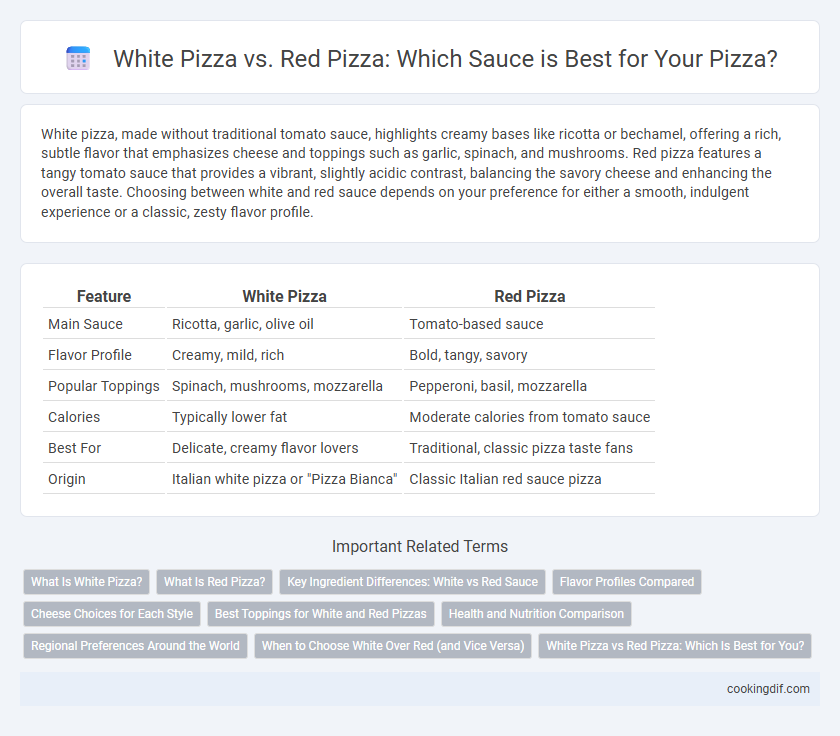White pizza, made without traditional tomato sauce, highlights creamy bases like ricotta or bechamel, offering a rich, subtle flavor that emphasizes cheese and toppings such as garlic, spinach, and mushrooms. Red pizza features a tangy tomato sauce that provides a vibrant, slightly acidic contrast, balancing the savory cheese and enhancing the overall taste. Choosing between white and red sauce depends on your preference for either a smooth, indulgent experience or a classic, zesty flavor profile.
Table of Comparison
| Feature | White Pizza | Red Pizza |
|---|---|---|
| Main Sauce | Ricotta, garlic, olive oil | Tomato-based sauce |
| Flavor Profile | Creamy, mild, rich | Bold, tangy, savory |
| Popular Toppings | Spinach, mushrooms, mozzarella | Pepperoni, basil, mozzarella |
| Calories | Typically lower fat | Moderate calories from tomato sauce |
| Best For | Delicate, creamy flavor lovers | Traditional, classic pizza taste fans |
| Origin | Italian white pizza or "Pizza Bianca" | Classic Italian red sauce pizza |
What Is White Pizza?
White pizza, also known as pizza bianca, is a sauce-less or cheese-based pizza that typically forgoes traditional red tomato sauce in favor of ingredients like ricotta, mozzarella, garlic, olive oil, and sometimes bechamel or cream. This style emphasizes a creamy, rich flavor profile, offering a lighter, less acidic alternative to red sauce pizzas. White pizza appeals to those seeking a distinctive taste experience without the tanginess or robustness associated with tomato-based sauces.
What Is Red Pizza?
Red pizza features a tomato-based sauce made from crushed tomatoes, garlic, olive oil, and herbs, delivering a rich, tangy flavor that complements a variety of toppings. This classic sauce provides acidity and moisture, balancing the dough's texture and enhancing the overall taste profile of traditional pizzas like Margherita or Pepperoni. The robust nature of red sauce pairs well with mozzarella and toppings such as sausage or mushrooms, making it a staple in many pizzerias worldwide.
Key Ingredient Differences: White vs Red Sauce
White pizza features a creamy base often made from ricotta, garlic, and olive oil, providing a rich, smooth texture without tomato. Red pizza uses a tomato-based sauce rich in herbs like basil, oregano, and garlic, offering a tangy and savory flavor profile. The key ingredient difference lies in the absence of tomatoes in white sauce, which results in a milder, less acidic taste compared to red sauce.
Flavor Profiles Compared
White pizza features a creamy, garlic-infused sauce often made from ricotta, mozzarella, and Parmesan cheeses, delivering a rich and mild flavor profile. Red pizza utilizes a tomato-based sauce seasoned with herbs like oregano and basil, offering a tangy, vibrant taste with subtle sweetness and acidity. Choosing between white and red sauces depends on whether you prefer a smooth, cheesy experience or a bold, zesty tomato flavor.
Cheese Choices for Each Style
White pizza typically features a blend of ricotta, mozzarella, and Parmesan cheeses, creating a creamy, rich base without tomato sauce, emphasizing delicate, mild flavors. Red pizza relies on mozzarella as the primary cheese, paired with robust tomato sauce to balance acidity and enhance the overall taste profile. Choosing fresh, high-quality cheeses for white pizza complements herbs and garlic, while for red pizza, the cheese's melting quality supports the sauce's vibrant, tangy character.
Best Toppings for White and Red Pizzas
White pizza, typically featuring a ricotta or bechamel base, pairs exceptionally well with toppings like spinach, garlic, mushrooms, artichokes, and smoked chicken, enhancing its creamy and delicate flavor profile. Red pizza, with a robust tomato sauce, complements toppings such as pepperoni, Italian sausage, black olives, fresh basil, and mozzarella, which balance acidity and add savory depth. Understanding these pairing nuances helps elevate the pizza experience by highlighting optimal flavor combinations for each sauce choice.
Health and Nutrition Comparison
White pizza, typically topped with ricotta, mozzarella, and garlic, offers lower acidity and fewer carbohydrates compared to traditional red pizza sauces made from tomatoes. Red pizza sauce is rich in lycopene, an antioxidant linked to reduced risk of chronic diseases, but contains natural sugars and higher acidity that may affect digestive health. Choosing between white and red pizza sauce depends on individual dietary needs, with white sauce favoring lower acidity and red sauce providing beneficial antioxidants and vitamins.
Regional Preferences Around the World
White pizza, popular in regions like New York and parts of Italy, features a creamy base made from ricotta, mozzarella, and garlic, catering to those who prefer a milder, cheese-forward taste without tomato sauce. Red pizza, dominant in southern Italy, the United States, and Latin America, emphasizes rich, tangy tomato sauce that complements a variety of toppings and appeals to lovers of bold, traditional flavors. Cultural influences and local ingredient availability strongly shape regional preferences, making sauce selection a key factor in defining authentic pizza styles worldwide.
When to Choose White Over Red (and Vice Versa)
White pizza excels when seeking a creamy, garlic-infused flavor that highlights cheese and toppings without the acidity of tomato sauce, ideal for lighter, vegetable-heavy pies or when paired with delicate herbs like rosemary and thyme. Red pizza, rich with tangy tomato sauce, complements robust meats like pepperoni and sausage, providing a bold, classic foundation that balances savory and sweet ingredients. Select white sauce for a subtle, smooth taste that enhances fresh cheeses and seafood, while red sauce suits hearty, traditional combinations demanding a vibrant, zesty backdrop.
White Pizza vs Red Pizza: Which Is Best for You?
White pizza features a creamy, garlic-infused base often made with ricotta or Alfredo sauce, appealing to those who prefer a rich, subtle flavor profile without tomato acidity. Red pizza uses traditional tomato sauce, offering a tangy, vibrant taste packed with herbs like oregano and basil, ideal for fans of classic, robust flavors. Choosing between white and red pizza depends on whether you favor a smooth, cheesy richness or a zesty, savory tomato experience.
White pizza vs Red pizza for sauce selection Infographic

 cookingdif.com
cookingdif.com